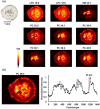A monolithic microfluidic probe for ambient mass spectrometry imaging of biological tissues
- PMID: 37782224
- PMCID: PMC10823490
- DOI: 10.1039/d3lc00637a
A monolithic microfluidic probe for ambient mass spectrometry imaging of biological tissues
Abstract
Ambient mass spectrometry imaging (MSI) is a powerful technique that allows for the simultaneous mapping of hundreds of molecules in biological samples under atmospheric conditions, requiring minimal sample preparation. We have developed nanospray desorption electrospray ionization (nano-DESI), a liquid extraction-based ambient ionization technique, which has proven to be sensitive and capable of achieving high spatial resolution. We have previously described an integrated microfluidic probe, which simplifies the nano-DESI setup, but is quite difficult to fabricate. Herein, we introduce a facile and scalable strategy for fabricating microfluidic devices for nano-DESI MSI applications. Our approach involves the use of selective laser-assisted etching (SLE) of fused silica to create a monolithic microfluidic probe (SLE-MFP). Unlike the traditional photolithography-based fabrication, SLE eliminates the need for the wafer bonding process and allows for automated, scalable fabrication of the probe. The chamfered design of the sampling port and ESI emitter significantly reduces the amount of polishing required to fine-tune the probe thereby streamlining and simplifying the fabrication process. We have also examined the performance of a V-shaped probe, in which only the sampling port is fabricated using SLE technology. The V-shaped design of the probe is easy to fabricate and provides an opportunity to independently optimize the size and shape of the electrospray emitter. We have evaluated the performance of SLE-MFP by imaging mouse tissue sections. Our results demonstrate that SLE technology enables the fabrication of robust monolithic microfluidic probes for MSI experiments. This development expands the capabilities of nano-DESI MSI and makes the technique more accessible to the broader scientific community.
Conflict of interest statement
There are no conflicts of interest to declare.
Figures





References
-
- Swales J. G. Hamm G. Clench M. R. Goodwin R. J. A. Int. J. Mass Spectrom. 2019;437:99–112. doi: 10.1016/j.ijms.2018.02.007. - DOI
Publication types
MeSH terms
Grants and funding
LinkOut - more resources
Full Text Sources

